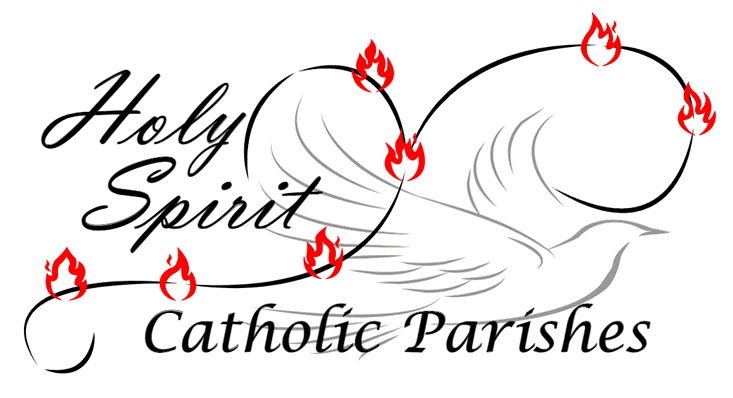History
History of Holy Trinity, Hartington, Nebraska
The history of the Catholic Church in Cedar County begins with the labors of Fr. Peter Jean DeSmet who is described as a "great missionary pioneer" in Henry Casper's book "The History of the Catholic Church in Nebraska." DeSmet traveled all through Nebraska and the Dakotas attempting "to check the untamed spirits of these wild Indians" with "devotion to the improvement of the red man.” He came up the Missouri to Yankton in the year 1839 in a hollowed out boat some ten feet in length and a foot and one-half in width with the intention of promoting peace between the Sioux and Potawatomi Indian Tribes.
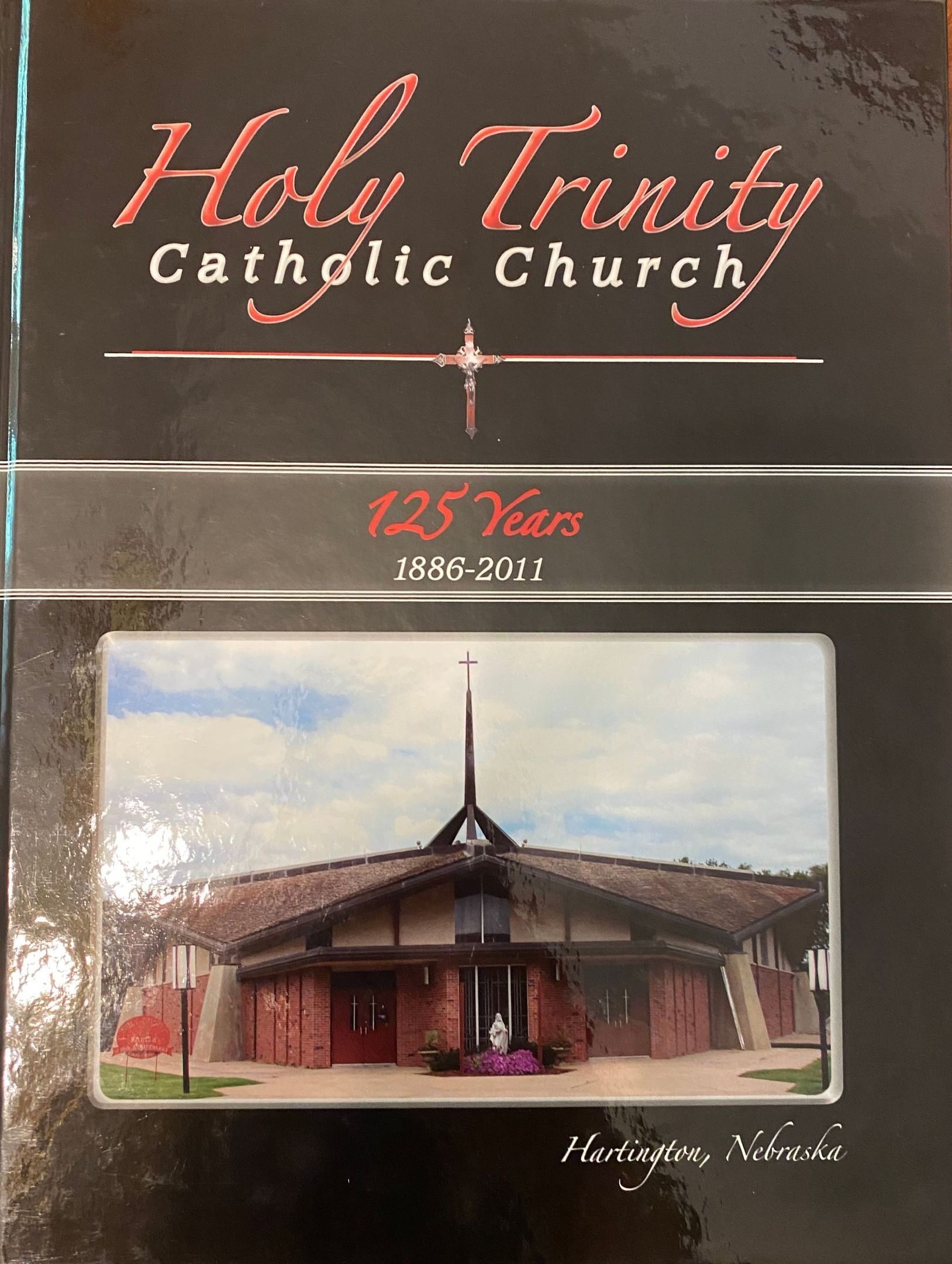
History excerpts from Holy Trinity Catholic Church, Hartington, Nebraska, 125 Years 1886-2011, p.1-4.
Casper writes of DeSmet's "temperament and restless disposition" and describes him as fearless. "There is no doubt," Casper said, "that curiosity prompted the priest to cross the river to the Nebraska side." The early histories of this county say that he assembled the Indians for a Council some twenty miles from Hartington. There he celebrated what is thought to be the first Mass in Cedar County.
Fr. DeSmet would be an example of the pioneer priests, who fearlessly traveled the territory to minister to the Indians and the growing number of Catholic pioneers. These priests were also very independent, and tended to think they should run things. This would more than once bring them into conflict with their stubborn pioneer Parishioners, who organized to build their Churches, and because of that were sure they should be the ones who ran them.
Early history of the Church in Nebraska is full of references to such high spirited struggles, and historians agree that the fact that the Church survived intact is a triumph of faith.
Cedar County was organized on February 12, 1857, and the north end of Cedar County attracted numerous settlers. The Missouri River was then used by steamboats and was the main avenue of entry into the country. Pioneers were attracted to the abundant water supply, timber and the fertile land.
The first Catholic pioneer, John Andres, arrived in the area which was to be Cedar County in 1856, two years after Nebraska was organized as a territory, and eleven years before it was to become a state. He settled along Bow Creek near where the village of St. Helena would be.
The first Mass recorded for the pioneers was held in the home of Gerhard Arndt in 1861. The first Catholic Church was built of logs near St. Helena in 1862, near the vicinity where the chapel and cemetery are now located. Fr. Lechleitner was sent by Bishop O'Gorman to be the first resident Pastor in 1869. By 1871 when Fr. Daxacher arrived, the Parish numbered 100 families.
The accomplishments of our pioneer forefather cannot be overstated. The hardships they had to undergo are best described by an early newspaper article which stated: "some of the wives of the pioneers who landed at St. Helena wept bitterly when they saw the boat steam away because of the wild and desolate surroundings and the thought of the many hardships and dangers they would be called upon to endure." Some did not survive. Some went back east. But the bravest and the best stuck it out, and all over Cedar County Churches were built, each spire defying the elements, announcing people strong in their faith.
The town of Hartington was founded in the fall of 1883. Chester A. Arthur was President and progress was coming to the prairie. Hartington was chosen as a railhead. The coming of the railroad was greeted with great satisfaction by the pioneers. River travel to St. Helena was hazardous in the summer and impossible in the winter. Wagon travel was slow and tedious. The railroad meant accessibility to the rest of the world, and most important, to markets. The marketing of the crops the early settlers had wrested from the soil had been more of a problem to the pioneers than the production itself.
Cedar County was then 25 years old. According to early historians, the location of the townsite of Hartington, which was soon to be the home of Holy Trinity Parish, was wisely chosen. William Huse, the founder of the Hartington Herald, called it a "panorama of splendor" in an article published on October 24, 1883.
He described "luxuriant valleys" and "sparkling streams" and the "broad expanse of virdue gay with flowers and farm houses, groves and cultivated fields" which he suggested was a "complete duplicate of Eden."
The original townsite was described as virgin prairie, but with the two branches of the Bow Creek supplying an abundant water supply, to providing the town in its future growth.
Many of the early settlers were Catholics, and within a few months after the founding of the town they decided to organize the Parish and build a Church.
There is a difference of opinion as to where the first Church was built, and accurate records are no longer available. The fact remains, the pioneers had a firm foundation in faith. And building a Church was one of the first priorities.
August Lubeley, one of these early pioneers, called a meeting of the few Catholic settlers to determine what could be done. The men who attended this first Parish meeting were August Lubeley, Joe Koeppel, Frank, Nick and John Schnettler, Werner Burbach, Adam Woerdehoff, Casper Machenbrock, Mike Michaels, J.J. Lammers, Daniel Felber, Mike, John and Jake Dendinger, and Henry Stuckenhoff.
By this time Hartington was being described by pioneer editor Huse as a booming city of vitality. Business houses lined Broadway and Main streets, and Huse described them as built "in the best taste and style, having good stone foundations and generally an air of permanence, indicating that the builders were there to stay." His words were prophetic, because numbered among the Parishioners of Holy Trinity in the year 2011, are many descendants of the early pioneers.
Huse described the citizens as "double distilled lightning in their enterprise and vigor."
The meeting of the early pioneers, which might now be looked on as the very first Parish council, was held in a lumber yard. The men decided to build a small Church in Hartington, which is the center of Cedar County. It would be known as the Holy Trinity Catholic Church.
According to records in the Cedar County Court House, in Book 9, page 347, on March 28th, 1884, Northern Nebraska Land Company deeded to the Bishop of the Catholic Church lots 1, 2, 3, 4, 5, & 6 of Block 80 Original Town of Hartington.
In book 13, page 112, records show that Hames O'Connor, Bishop of Omaha, deeded to Holy Trinity Church those same lots on September 9, 1887. Records also show Holy Trinity Church purchased lots 4, 5, 6, 7 and 8 of Block 79 on November 22, 1897.
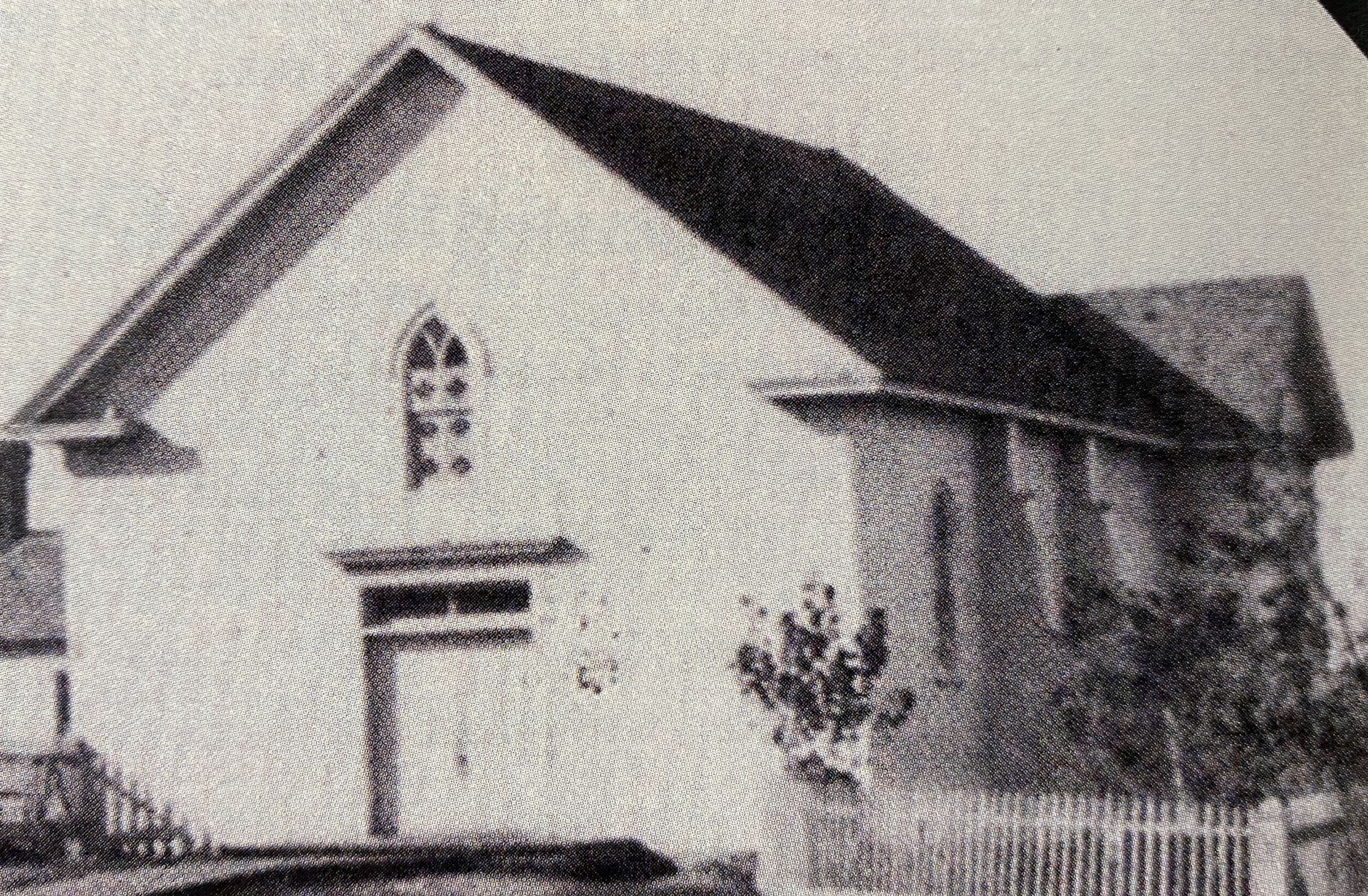
First Holy Trinity church 1884-1903.
Work on the log structure began in the late fall of 1883 or early spring of 1884, less than a year after the townsite had been laid out.
The Church building was completed on June 12, 1884. Reverend Fred Uhing, Pastor of Bow Valley, celebrated the first Holy Mass in the new building sometime during the week of June 12.
The Church was 76 feet long with an average width of 25 feet and height of 20 feet. It was one of the largest in this part of the state.
It is noteworthy to mention, and typical of the dedication of the pioneers, that the men of the Parish assumed the responsibility of building the first Church. Among these were August Lubeley, Adam Woerdehoff, W.H. Burbach, M.P. Dendinger, Joseph Koeppel, Frederick Reifert, Frank Schnettler, Casper Machenbrock, Anthony Walz, Louis Goetz and John Goebel. Some of these men contributed $100 and also constructed the building. Rock for the foundation was gathered from the prairie and John Dendinger is said to have brought the first load.
Temporary benches were installed for immediate use while been harvested. the other interior details waited until the next year's crop had Holy Trinity's Centennial was celebrated in 1986 because 1886 was the year of the coming of the first resident Pastor. Until that time, from 1884 when the Church was built, Holy Mass was said only once a month. The Rev. Henry Schoof, Pastor of St. Helena, or the Rev. Fred Uhing, Pastor of Bow Valley, came on horseback or by horse drawn vehicle to Hartington to say Mass, and take care of the spiritual needs of the Catholics of this area.
By this time, Holy Trinity's sister Parish in Bow Valley had been in existence for ten years. They dedicated their Church, Sts. Peter and Paul, on November 1, 1875.
Holy Trinity Parish was officially incorporated into the Omaha Diocese on September 10, 1887.
The first resident Pastor was Rev. Henry Hoheisel, who came in 1886. He performed the first recorded marriage, baptism and burial. Records are not complete, but the first recorded baptism was that of Peter William Schnettler, son of John Schnettler, on June 1, 1886. In the year 1886 nineteen baptisms are recorded. The parents of these children resided at Center Bow, East Bow, Coleridge, Logan Valley, Wakefield, and Concord, as well as Hartington.
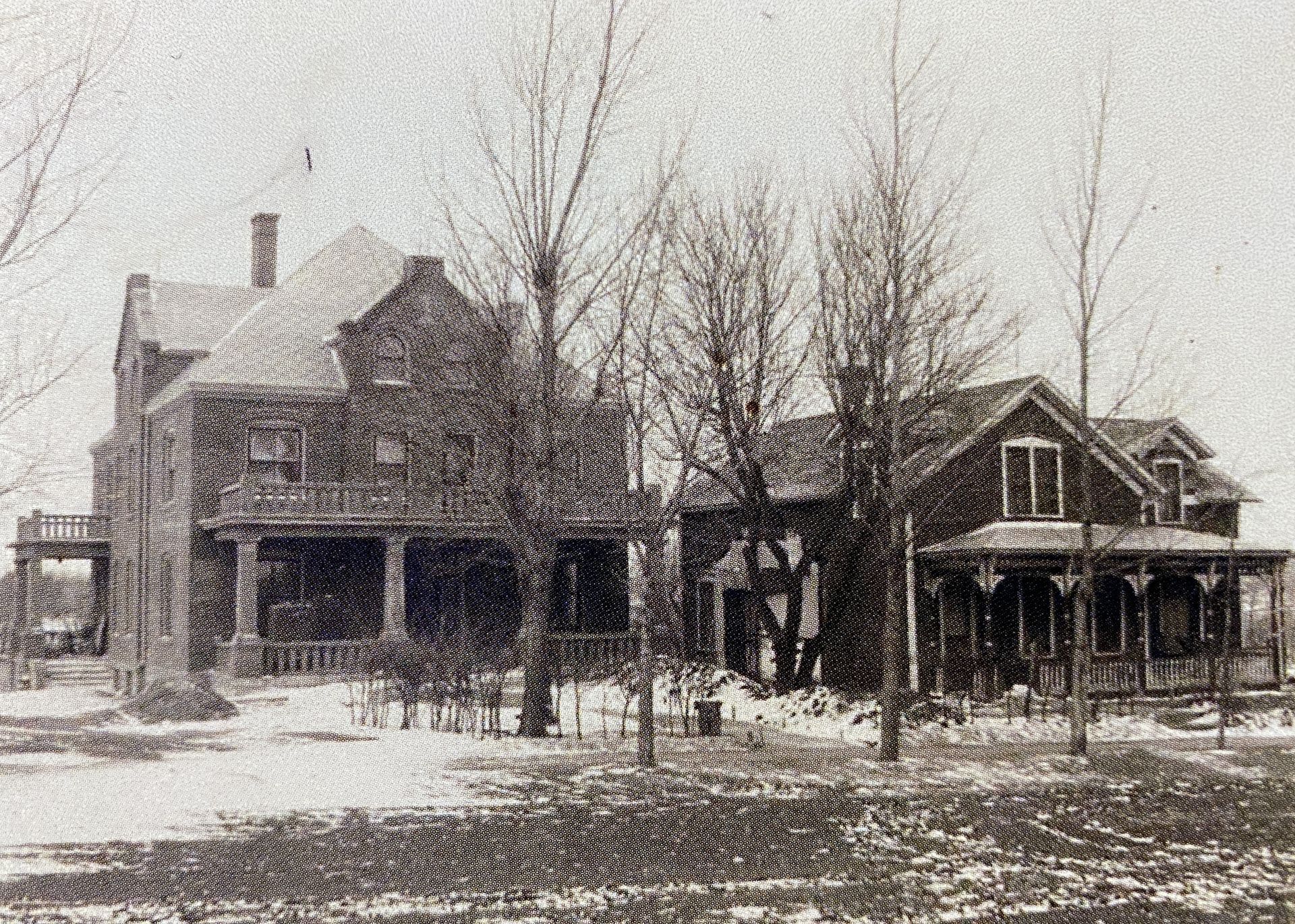
First Rectory on the right 1886-1913. Second Rectory on the left 1913-2011.
The first recorded marriage is that of Engelbert Dickes, son of Frank Dickes, and Catherine Konz, daughter of John Konz. The first recorded communion class was held on Pentecost Sunday, June 13, 1886.
The records of all of the Holy Trinity Parishioners are included elsewhere in this book. Louise Goetz was the first person to be buried from the Hartington's first Church, and that was on December 26, 1886.
The land for St. Michael's Cemetery was deeded to Holy Trinity on June 18, 1888, by J.J. Lammers and Susanna Lammers. Another piece was bought from Hartington Industrial Development, and in 1968, Paul and Theresa Kathol donated an additional 2.4 acres.
Many fine men held the position of caretaker at the cemetery, and perhaps nobody in the Parish had as unique a view of the Holy Trinity's history. Matt Kneifl held that position from 1926 to 1947. For the next 27 years Louis Haberman held the position. Haberman used a hand mower to mow the entire cemetery and took pride in restoring some of the old markers. Fr. Cyril Werner said "Louis spent many hours at the cemetery without any pay." The care of the cemetery is now entrusted to the men's fellowship of Holy Trinity Church under the supervision of the Parish Council.
Fr. John Hoheisel served as Pastor until February of 1887, when he was succeeded by Fr. John Killian.
History records that Fr. Killian, a priest of Irish descent, owned a fine trotting horse and frequently raced him at the fairgrounds. Fr. Killian served as Pastor "pro tem" until Fr. Schoof came in the late summer of 1887. Fr. Henry Loecker was appointed assistant Pastor.
On August 4, 1889, the Most Reverend James O'Connor came to Hartington to administer the Sacrament of Confirmation to a class of 15.
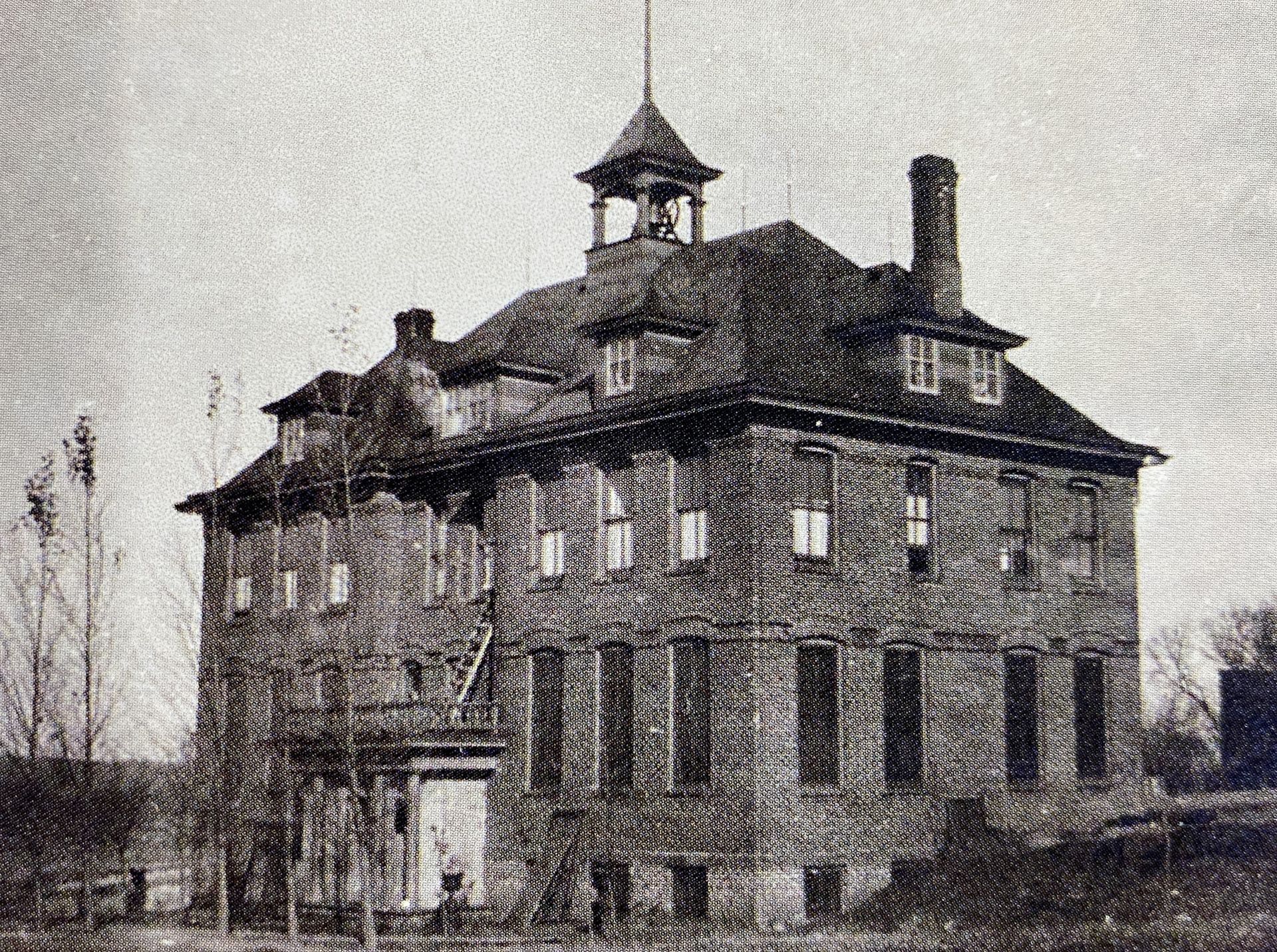
First school building 1900-1949.
In the fall of 1900, by the unanimous vote of the Parishioners the work of constructing a Parish school was begun. Anthony Walz and A.K. Lammers were chosen to take charge of constructing the building. The school was dedicated on January 3, 1901 and the same month, on January 9th, it was opened with an enrollment of 75 students who transferred from the Hartington Public School. By the fall of that year 155 students enrolled in grades one to nine, with 25 pupils in the first grade, and four in the ninth grade.
The first teachers were the Pastor, Fr. Loecker, and three nuns of the Ursuline order, Principal Mother Helen, and Mothers Ida, and Michtildes. Mother Caroline joined them later.
An additional grade of high school was added each year until 1905 when the first high school commencement was held. Graduating on June 29th, 1905, were: Anna (Goetz) Lubeley, Anna Amundson, Grace Wilson, Fred Wilson, Charles Schrempp and Fred Walz. It is interesting to note that one of these graduates, Charles Schrempp, became a lawyer, Grace and Fred Wilson became newspaper publishers, and Fred Walz a real estate broker.
By 1902 Holy Trinity Parish had grown to such an extent that a larger Church was needed. Plans were first made to enlarge the old Church with a $6,000 addition, but after deliberation the plans for a new and larger Church building were proposed and accepted. This Church, built at a cost of $15,000, was plain and simple, but larger and more durable than the first. An additional $421 was spent on two new furnaces for the Church.
The Church was built by noted pioneer builder Henry Stuckenhoff, who also built the Church in St. Helena in 1896, and a number of other buildings and homes which are still in existence. Ironically, entering a note of sadness, the first person to be buried from the new Church was Mrs. Stuckenhoff, the wife of the man who built it.

Second Holy Trinity church 1903-1950.
On March 8, 1903, Fr. Loecker, the Pastor, celebrated the first Holy Mass in the new Church, a solemn High Mass. In the afternoon the tabernacle and the statues were blessed. On June 13, 1903, the first Corpus Christi procession was held and on July 8th, of the same year, the Very Reverend Dean Wolf of Grand Island, acting as the delegate of the bishop, solemnly dedicated the new building.
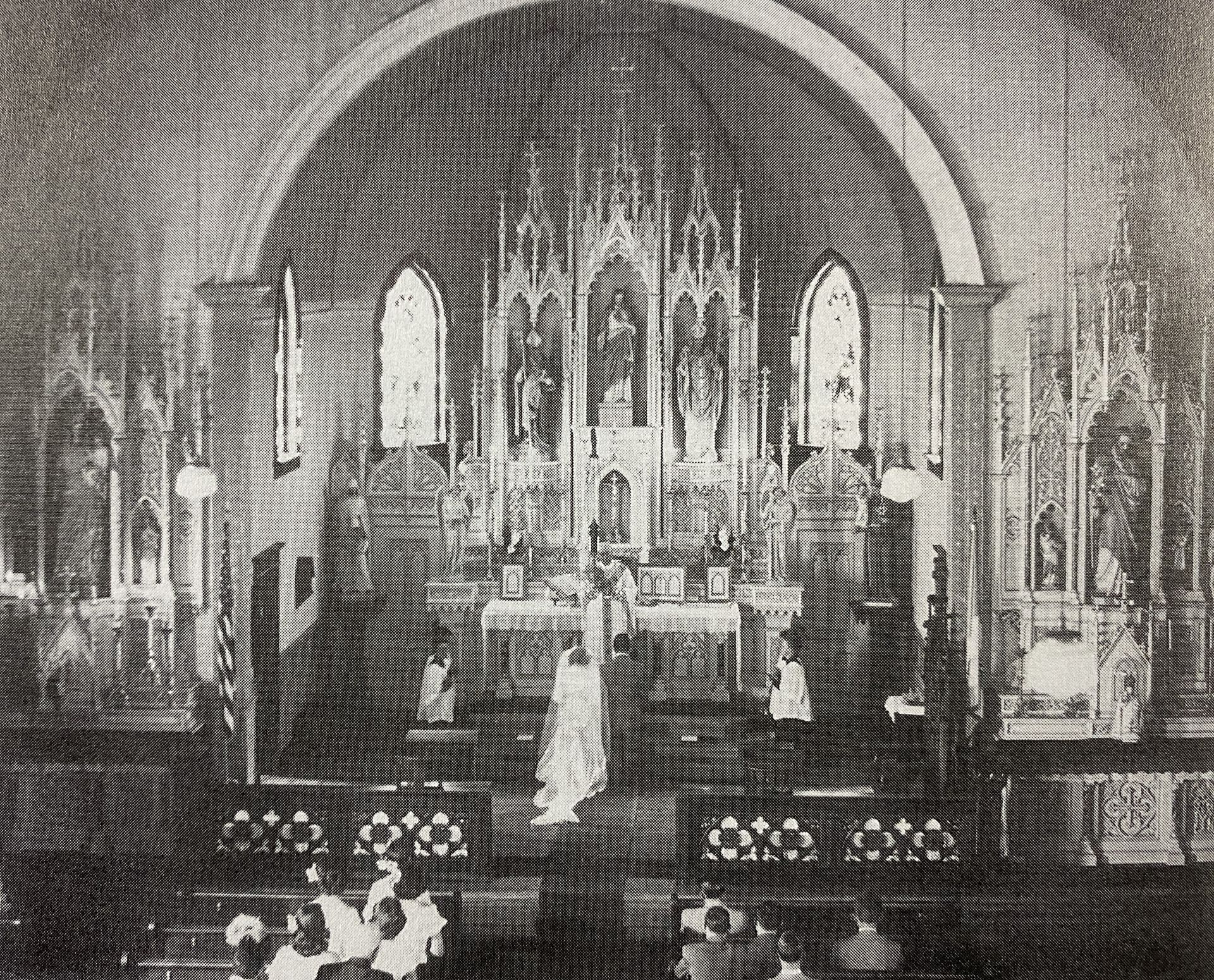
Interior of second Holy Trinity church 1903-1950.
After the transference of Fr. Loecker in 1904, Reverend George J. Glauber became Pastor of Holy Trinity Parish Fr. Glauber's assistant was Fr. Bosheck, who became Pastor "pro tem" after Fr. Glauber's death in 1909, until the appointment of Fr. Ferdinand Schnuettgen. In the years following Fr. Schnuettgen's appointment he saw the congregation increase to over 200 families.
The enrollment of the Parish school, in which he took a special interest, increased until in 1913 an additional east wing was added to accommodate the school children. In the history of Cedar County by Addison E. Sheldon (1937) it states: "The school building, built on an adjoining lot north of the Church, has grown through a succession of enlargements for more than a third of a century, from a little frame structure to a large brick building." In 1910 a normal training course was added to the curriculum and in 1926 a commercial department was installed.
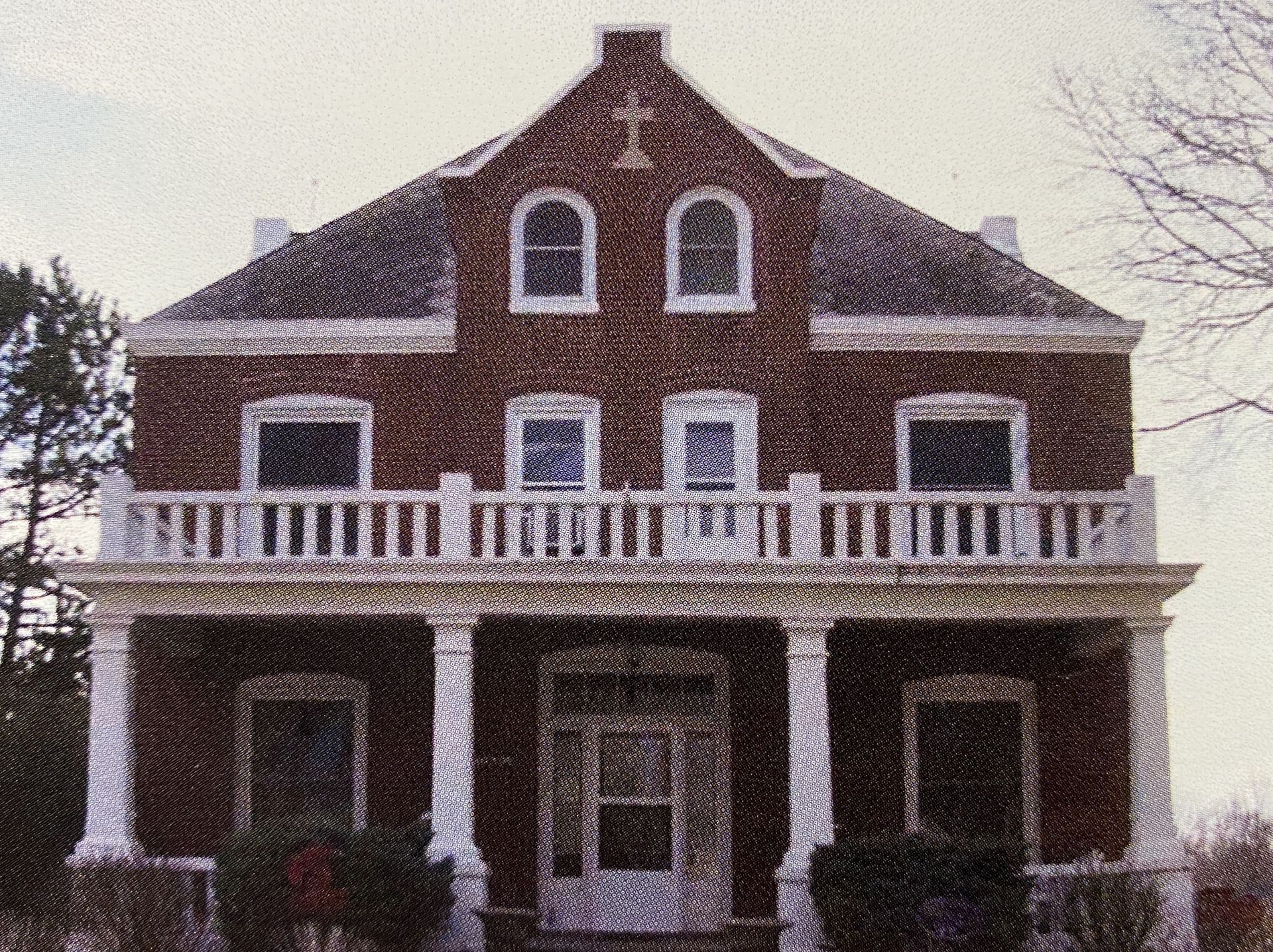
Rectory 1913-2011.
A new all brick Parish house was constructed in 1913, again by Henry Stuckenhoff, at a cost of $9,775.
This was the time of World War I, when the United States went to war with Germany. It was a sometimes troubled time in the history of Holy Trinity because, in deference to most of the Parishioners, who'd come over from Germany, the German language was still being used during the Mass. There were some townspeople who, because of the continued use of German, called into question the patriotism of the Parishioners and especially of Fr. Schnuettgen. Colorful stories exist of a night when a torch-bearing mob marched up the hill to the rectory intent on having a show down with Fr. Schnuettgen, but Fr. was spirited out by his Parishioners and the furor over it all eventually died down. However, interviews with a number of people about this time give evidence that it is still a painful memory for some of our older Parishioners. Many lessons in forbearance and forgiveness were learned at that time.
Fr. Schnuettgen's death while on a trip to Germany late in 1930 ended his career of 21 years of service in Holy Trinity Parish.
Fr. Bernauer was the acting Pastor during Fr. Schnuettgen's absence and continued in this capacity after Fr.'s death until the Rt. Rev. Msgr. B.H. Lordemann was appointed Pastor in the fall of 1930. Msgr. Lordemann had been Pastor of St. Frances Church at Randolph.
In 1940, the older school building was again over-crowded. A new school building was constructed south of the old building. The plans were made so that only the first floor of this building be completed at that time but a second and even a third story could be added as the need arose. It cost approximately $27,000. The grade school classes were taught in this building while the high school classes were still being held in the old building.
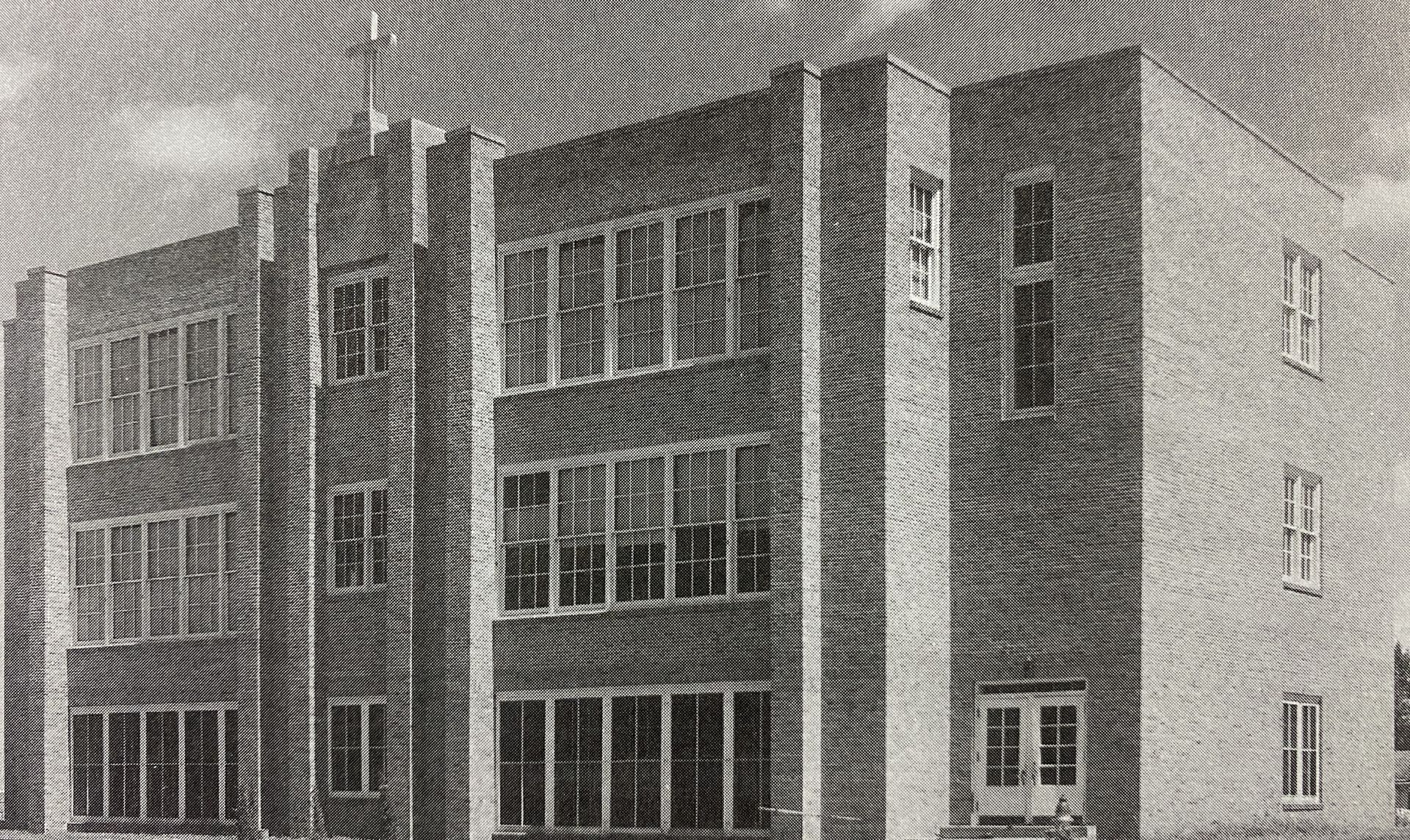
New school building built in stages starting in 1940.
In 1943, the Ursuline Sisters left Holy Trinity and Nebraska in order to concentrate on larger schools and academies, especially in the East. The Benedictine sisters of Sacred Heart Convent of Yankton, South Dakota, came to replace them.
The first Benedictines in Holy Trinity Grade school on August 24, 1943, were Grades 1 and 2, Sister Agnes; Grades 3 and 4, Sr. Verena; Grades 5 and 6, Sr. Luke; and Grades 7 and 8, Sr. Charles. The first sisters to teach at Holy Trinity High School were Sr. M. Beata Meyer, Principal, Sisters Gemma, Thaddes, Teresine, and Miriam.
In 1948 it was decided that the old high school building was unsafe so on May 14, 1949, the last class graduated from the old school. Two additional floors were added to the grade school building to accommodate the high school. The new addition was dedicated by the Most Rev. Gerald T. Bergan on September 5, 1949. The day was marked as one of special joy for the new $160,000 addition was debt free by the day of its dedication due to the generosity of Parishioners and friends of Holy Trinity. The old high school was destroyed.
In the fall of 1950 a full time coach was employed to handle the enlarged athletic program. Until that time the coaching had been done on a volunteer basis. One of the beloved coaches who served in a volunteer capacity for many years was Kenny Miller, who at one time ran the Ford Agency in Hartington.
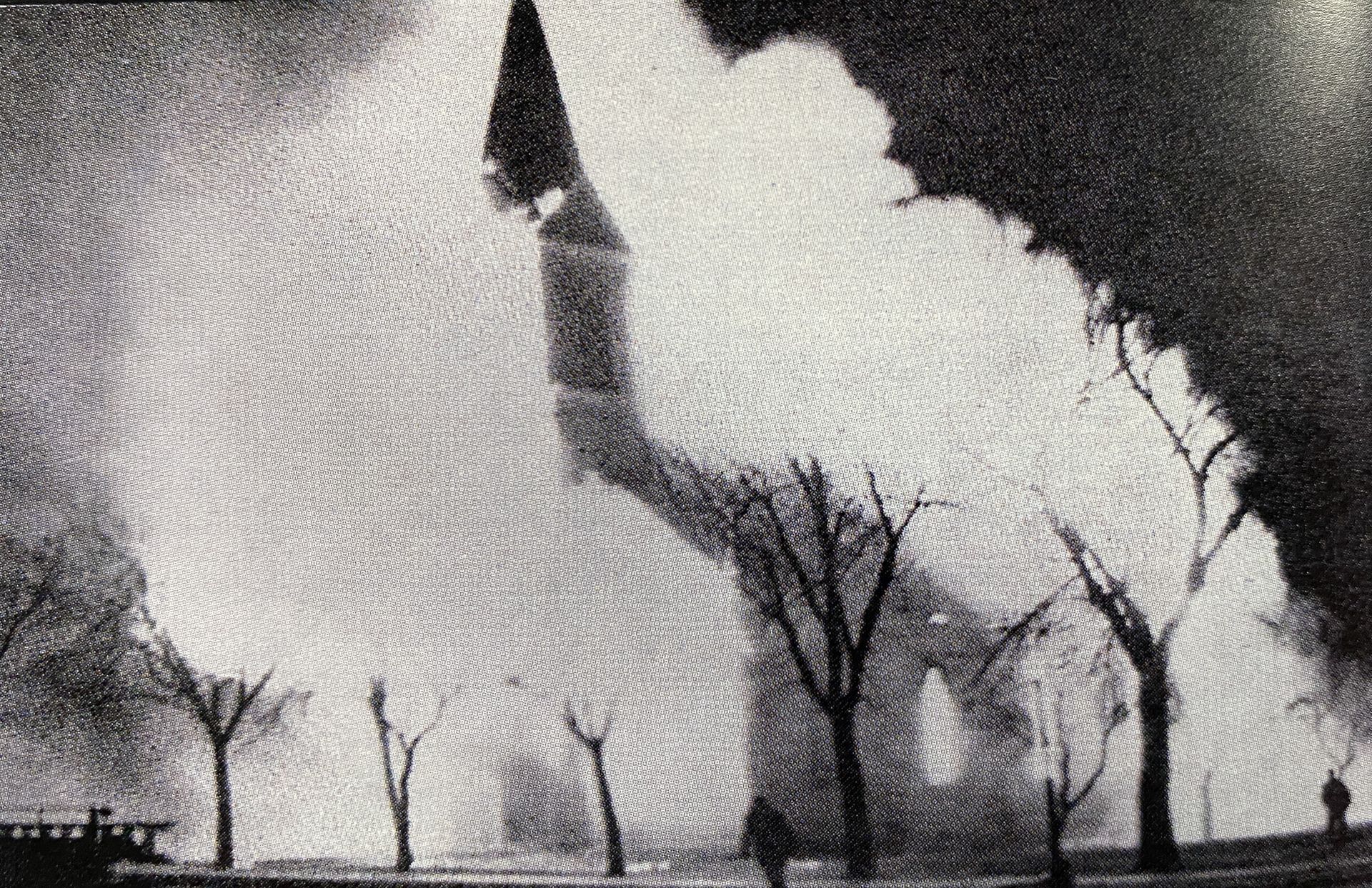
Second church burned Thanksgiving Day 1950.
In the fall of 1950, the Church which had been erected in 1903, burned to the ground. The fire was detected at 4:15 in the morning, after it had been burning for some time. The building and the contents were a total loss. Parishioners were determined to have a Church where they could gather at the divine services. At a Parish meeting the following Sunday, it was decided to erect a metal building to temporarily house the Church.
The work on this project was begun as soon as the materials were made available. On February 11, 1951, the first Holy Mass was celebrated in the new building. In the meantime, Sunday services had been held in the city auditorium with week day Masses in the corridor of the High School.
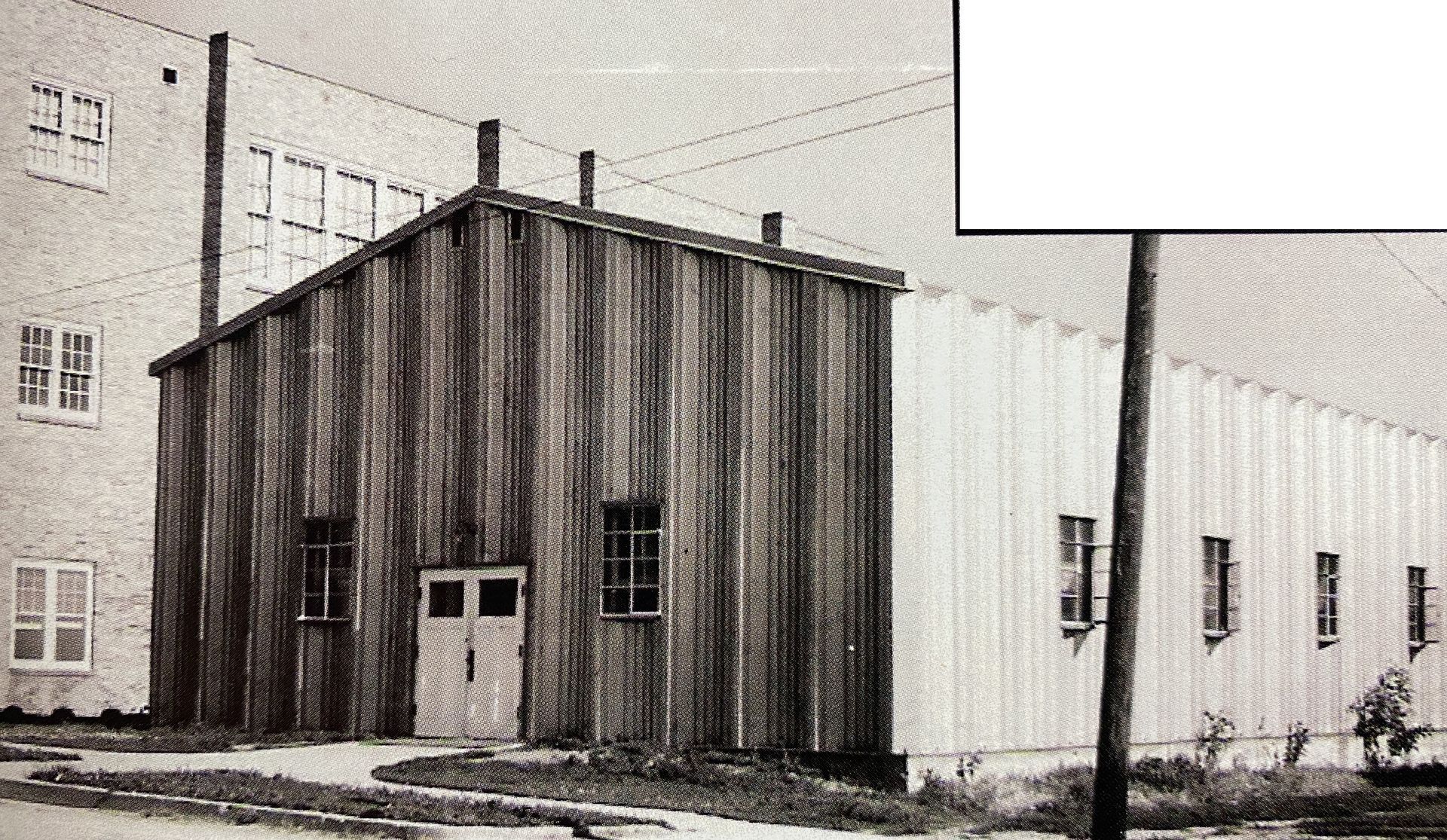
Interim church 1951-1967.
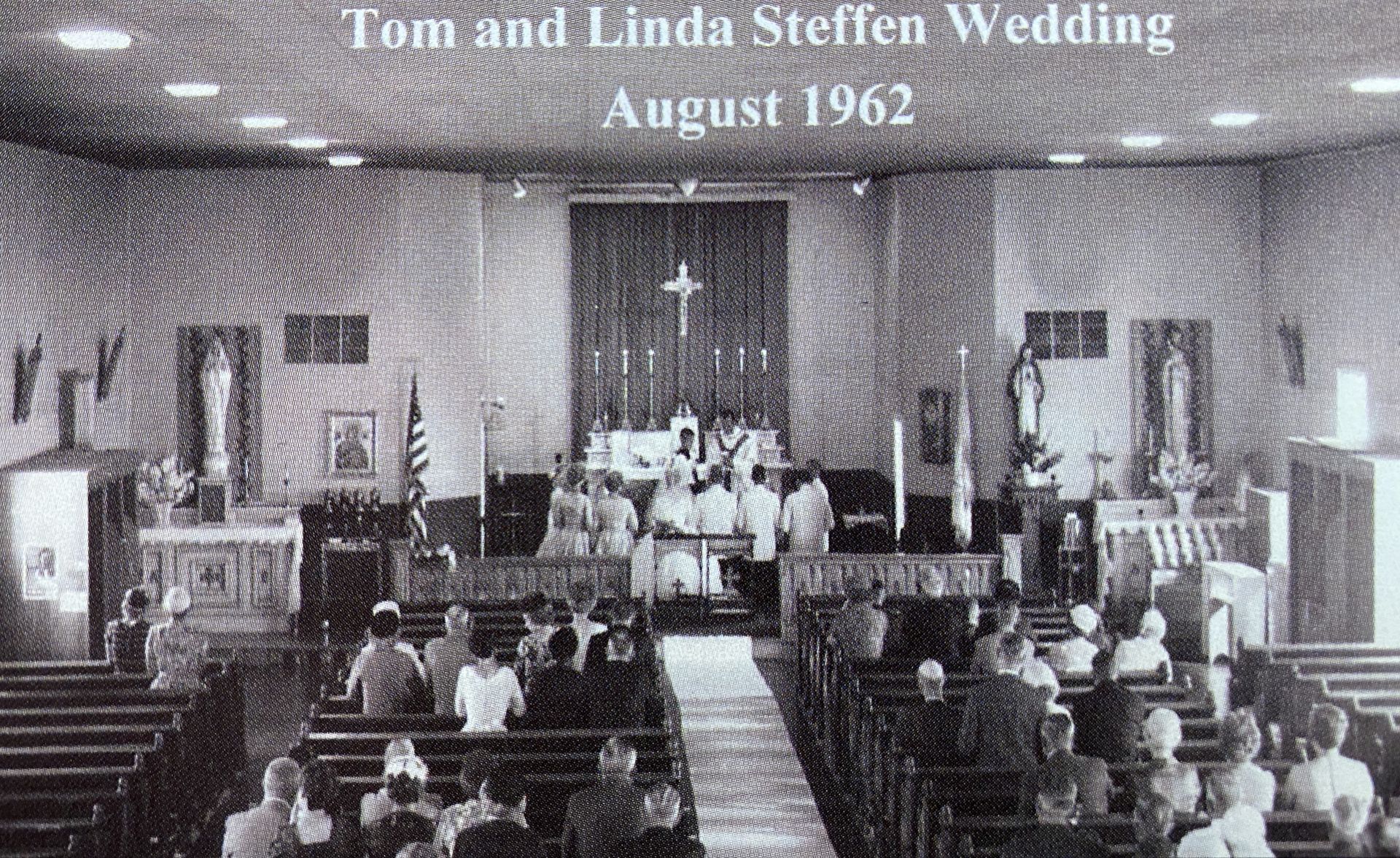
Interior of interim church 1951-1967.
By 1956 the enrollment in the grade and high schools had seen such an increase that another school building was necessary. A new grade school consisting of eight rooms, a spacious gymnasium or Parish center, a cafeteria and a well-equipped kitchen was planned. Through the untiring efforts of Fr. Farrald, the assistant Pastor, these plans were at last realized. On June 13, 1957, which was also the occasion of the fiftieth anniversary of Msgr. Lordemann's ordination to the priesthood, the new school was solemnly dedicated.

New grade school 1957-Present.
An early history states "Holy Trinity Parish had reached another milestone in its work for God and Country."
In March of 1957, under the direction of Fr. John Farrald, the Holy Trinity Cafeteria began operation. The first cooks were Martha Foecke, Veronica Stevens, Francis Kalin and Mary Litz. Two hundred and fifty meals were served each day.
During the school year of 1959-60 Msgr. Lordemann's health failed and he was no longer able to carry on his labors in the Parish. In June of 1960, Fr. Raymond Auer of St. Frances Parish in Randolph was appointed to succeed him. On July 11, 1960, Msgr. Lordemann died. During his Pastorate at Holy Trinity he had supervised the erection of a three-story high school, a fine up-to-date grade school with gym and cafeteria and a temporary Church building.
He'd served Holy Trinity Parish with great holiness and humility for almost thirty years, and the people are deeply indebted to him for his zealous labors on their behalf.
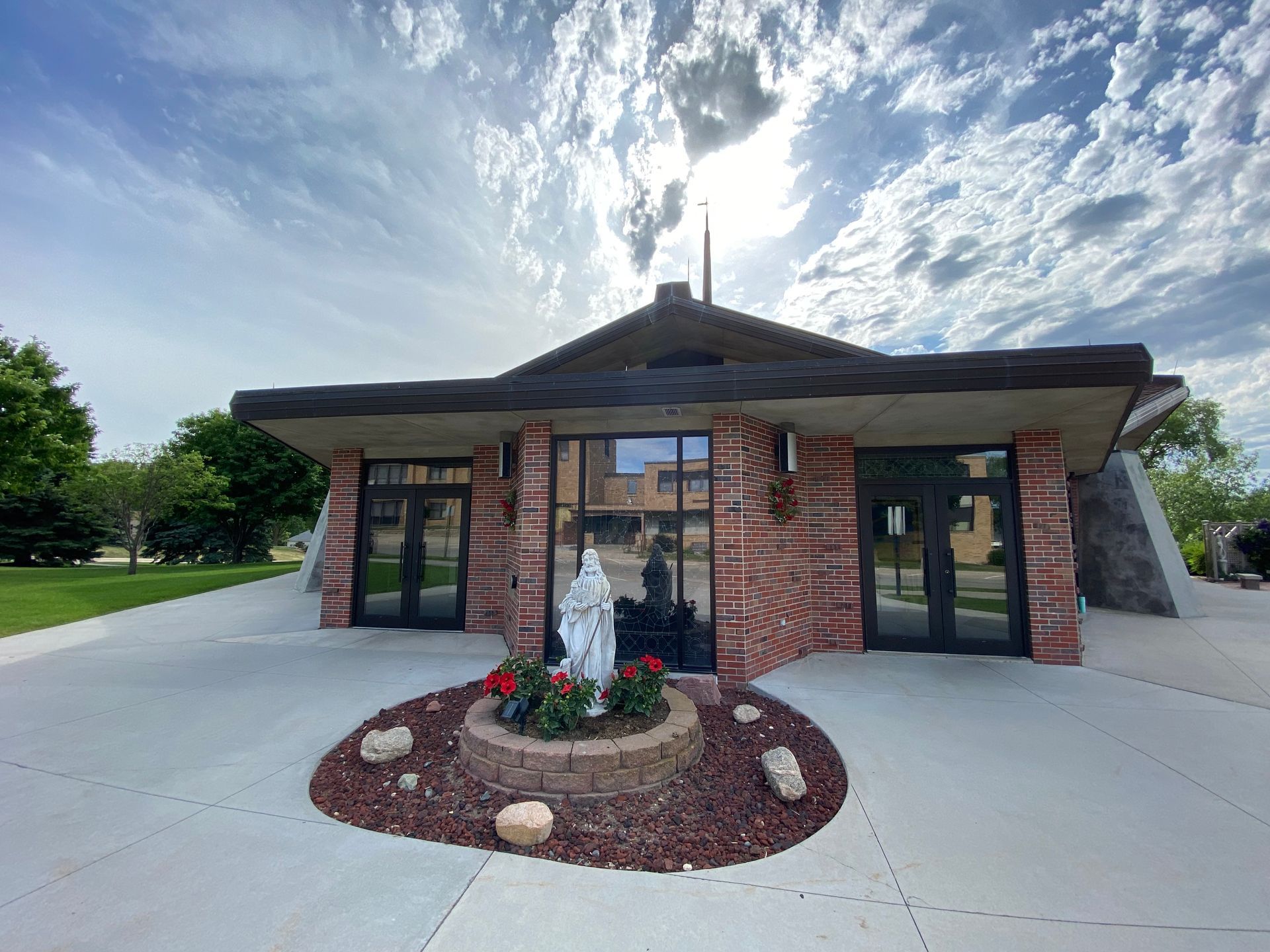
Current Holy Trinity Church built in 1967.
Fr. Auer served Holy Trinity Parish from 1960 to 1969. He was an innovator, and as a forerunner of the now widely accepted Parish Council, he organized what he called a "21 man committee” to help him run the Parish. He also started Perpetual Adoration. And it was during Fr. Auer's time, in the year 1967, that the modern hexagonal Holy Trinity Church was built on the site of the original Church that burned down. The "temporary" Church had been in use for some 16 years. The new Church was built at a cost of $270,000 by RaDec Construction.
It was during Fr. Auer's tenure that the Archbishop directed the consolidation of Holy Trinity School to take in high school students from Coleridge, Fordyce, Constance, St. James, Menominee, Bow Valley, St. Helena, Laurel, Wynot, and Hartington. The school was re-named Cedar Catholic High School. A building was erected north of the Holy Trinity High School and the two buildings were joined together to make one unit. The cost of the new building was $400,000. The school was staffed by eight Benedictine sisters, two coaches, and five priests. Fr. John Flynn was the first superintendent. There were 238 students enrolled.
On September 19, 1969, Fr. Cyril Werner followed Fr. Auer to serve Holy Trinity Parish. In 1978, under Fr. Werner's guidance, the Parish was able to pay off the debt on the new Church.
In 1982 additional space was needed at Holy Trinity Grade School, and under the direction of Fr. Cyril Werner, a music room, three classrooms, two athletic locker rooms, an athletic storage room, and kitchen storage room were constructed. This new addition was dedicated on August 29, 1982, by Archbishop Daniel Sheehan.
Fr. Werner served the Parish with great dedication and humility during a time when the whole community was experiencing economic stress. The disastrous farm economy made money tight and just paying the bills was a challenge. He worked closely with the Parish Council, the Guild, and then, the newly organized, Finance Committee, as well as all the other Parish organizations to ensure the survival of our Parish and schools.
In order to survive, Fr. Werner and the Parishioners of Holy Trinity needed as much unselfishness, courage, determination, and fearlessness as was shown by our pioneer priests and our pioneer forefathers.
The focus of this book is on the last 25 years of Holy Trinity's history. You'll find the same traits in the past hold strong today. Our community of faith and love for one another allows us to build the future of Holy Trinity Parish.
(Holy Trinity Catholic Church, Hartington, Nebraska, 125 Years 1886-2011, p.1-4)
| Pastor | Years |
|---|---|
| Fr. Henry Hoheisel | 1886-1887 |
| Fr. Henry Schoof | 1887-1888 |
| Fr. Henry Loecker | 1888-1904 |
| Fr. George J Glauber | 1904-1909 |
| Fr. Joseph Bosheck | 1909-1909 |
| Fr. Ferdinand Schuettgen | 1909-1930 |
| Msgr. Bernard H Lordemann | 1930-1960 |
| Fr. Raymond G Auer | 1960-1969 |
| Msgr. Cyril J Werner | 1969-1989 |
| Fr. Franklin Dvorak | 1989-1995 |
| Fr. William Sanderson | 1995-2001 |
| Fr. John L Pietramale | 2001-2008 |
| Fr. Jeffery S Loeske | 2008-2016 |
| Fr. Owen Korte | 2016-Present |
| Associate | Years |
|---|---|
| Fr. Joseph Bosheck | 1908 |
| Fr. John D Maciejewski | 1923 |
| Fr. John S Juricek | 1924 |
| Fr. Edward J. Applebaum | 1927 |
| Fr. Joseph T Bernauer | 1929 |
| Fr. Clement A Beyersdorfer | 1931 |
| Fr. Joseph Bernauer | 1931 |
| Fr. Frederic Jrschik | 1932 |
| Fr. Otto A Buekler | 1935 |
| Fr. Aosiamus J Van Veen | 1936 |
| Fr. Ignatius C Spenner | 1939 |
| Fr. Ernest R Halemba | 1940 |
| Fr. Conrad J Kaup | 1942 |
| Fr. Edward Schrad | 1948 |
| Fr. James J Farrald | 1953 |
| Fr. William F Fitzgerald | 1958 |
| Fr. Thomas F. Kosuth | 1961 |
| Fr. Joseph Miksch | 1969 |
| Fr. Gerald Gondringer | 1974 |
| Fr. Donald Shane | 1976 |
| Fr. James Gaughan | 1977 |
| Fr. Dean G Uhing | 1980 |
| Fr. Michael Grewe | 1982 |
| Fr. Steven Stillmunks | 1986 |
| Fr. James Weeke | 1989 |
| Fr. Joseph Hiep Ho | 1989 |
| Fr. Ed Scdoris | 1990 |
| Associate | Years |
|---|---|
| Fr. Stanley T Schmit | 1997-2000 |
| Fr. John S Andrews | 2000-2003 |
| Fr. Garry Welsh | 2003-2004 |
| Fr. Kevin Vogel | 2023-Present |
Quick Links
Contact us
Office: 402-254-6559
Fax: 402-254-6553
email: holytrinity@hartel.net
406 South Broadway, PO Box 278
Hartington, NE 68739
